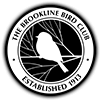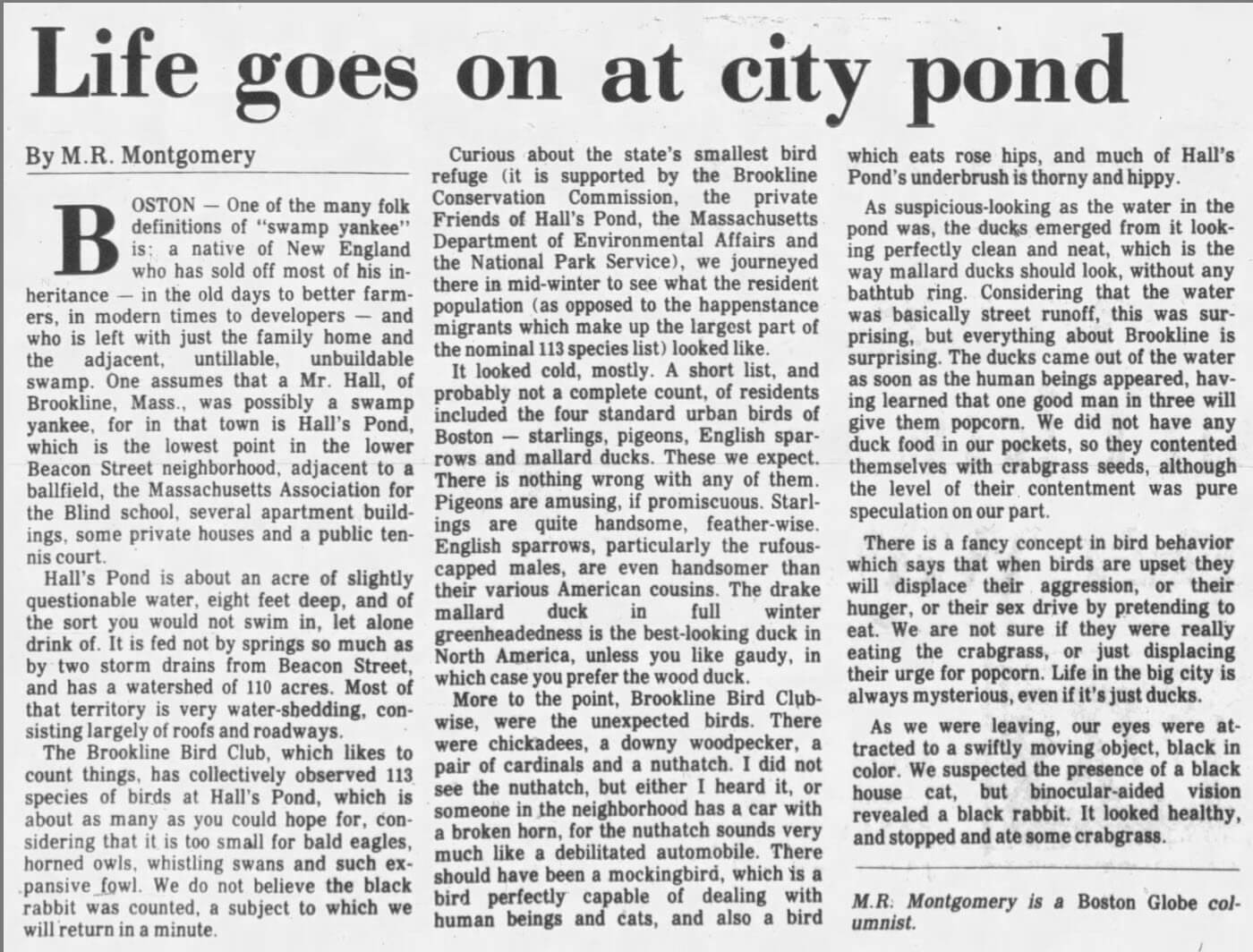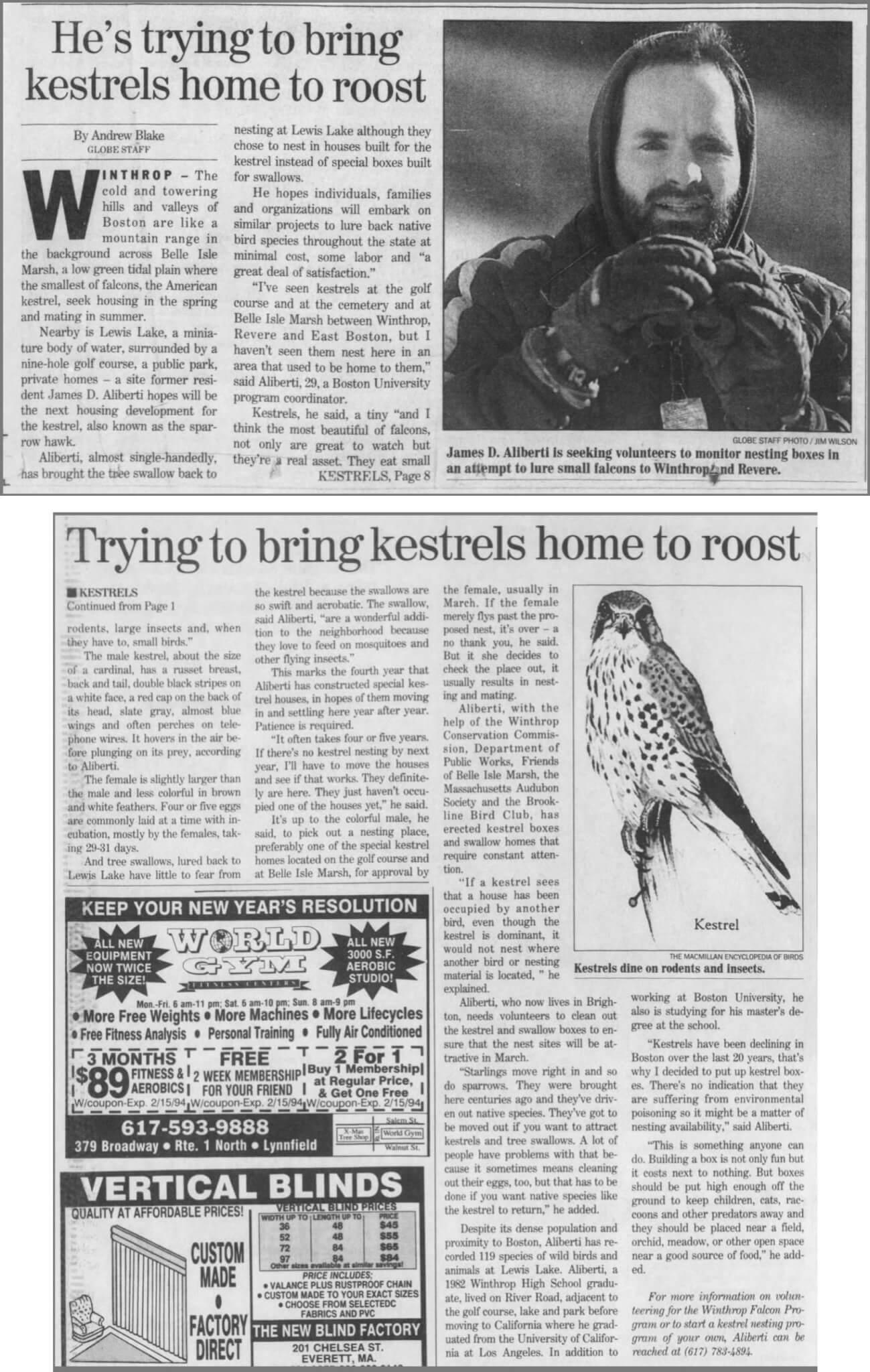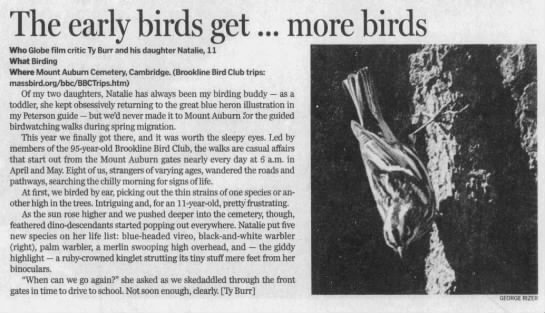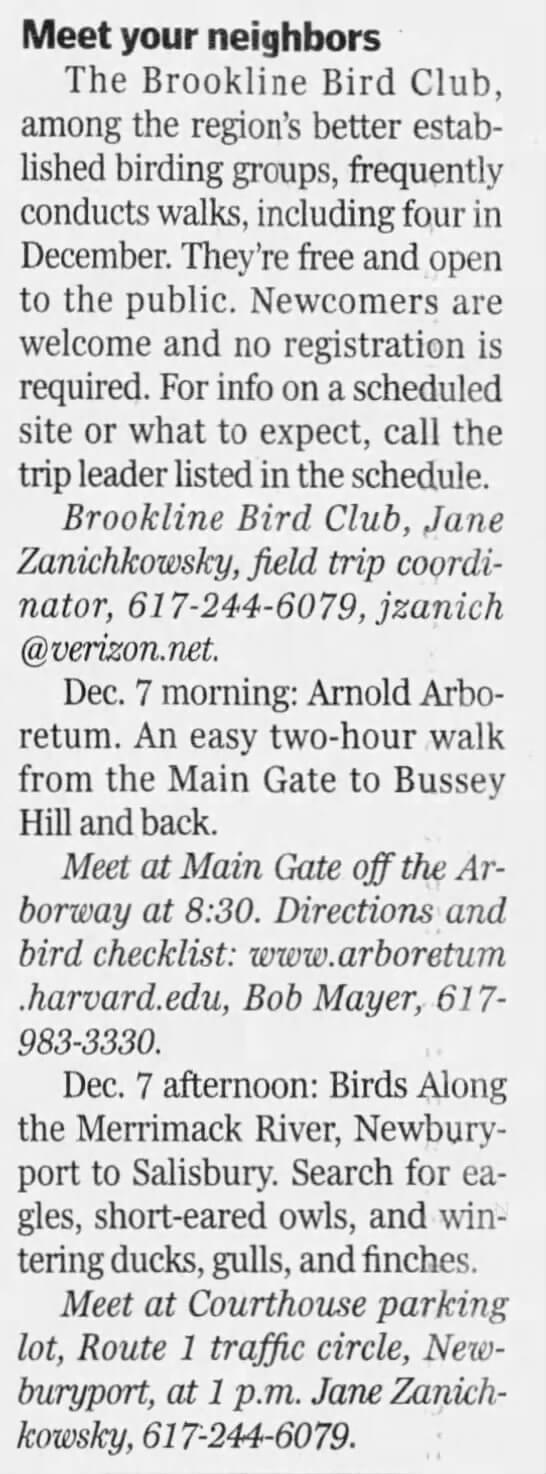The Brookline Bird Club: 1988-2013
The close of 1988 found the Brookline Bird Club on the brink of the Information Age. In the last decade of the 20th century, environmental concerns challenged members to redouble conservation efforts. At the same time, technological advances rewrote the rules for organizing trips and sharing reports.
Citizen’s Band radios kept cars together on BBC trips and helped solo birders. At birding hotspots like Plum Island, Gloucester, or Cumberland Farm fields, a member could put a call out about a sighting and, more often than not, another BBC member would respond looking for information. The last update of the BBC C.B. Radio List, in January 2002, included the handles (call signs) of 196 participants. Handles sometimes reflected the owner’s profession (such as Bank Swallow for Joe Paluzzi and Golden Crown for dentist Irving Romanow) or name (Chris and Judy Hepburn’s Rosy Finch came from the “Hepburn’s” form of the Gray-crowned Rosy Finch).
The club’s telephone hotline alerted the club’s avid listers to local rarities. Sabrina Hepburn recalls answering phone calls during dinner on a Friday or Saturday night and hearing ‘I’ve got a BBC hotline report.'” Periodically, the caller accidentally omitted some critical turn or instruction during this game of ‘Telephone,’ leading to “much cursing” when recipients tried finding the bird, but, like many BBC birders of the time, Sabrina feels that she owes “more than a few” life birds to the service.
A typical hotline situation occurred on January 10, 1992. Joseph Mann of East Gloucester put out some raisins for cardinals atop a Hav-A-Hart trap in his yard, and attracted a Yellow- breasted Chat. Mann invited Jerry Soucy and Judge Lawrence Jodrey to share the sighting and told Soucy he could tell anyone he wanted. Before the day ended, a “parade of birders” began. Thanks to the BBC Hotline, over 300 people saw the chat. Stan Bolton, who visited several times, got Mann to join the BBC. Wrote Mann, “Jerry Soucy had given me information before but I never realized all the great people and great birding I would enjoy with the club, not to mention all the lifers I’ve seen since joining.” (Mann 1992).
Brookline Bird Club directors took public relations seriously. Blue Books had included a statement emphasizing respect for private property since the 1960s. The club created a birding etiquette committee in 1991 and published its own Code of Ethics, adopted from the ABA code of ethics, to address concerns over birder behavior, particularly when in pursuit of rarities. The code included tenets such as “Birders must always act in ways that do not endanger the welfare of birds or other wildlife,” “Birders must always respect the rights of others,” and “Birders in groups should assume special responsibilities.”
While members enjoyed expanding their lists, they were also passionate about conservation. Meeting minutes reflect a longstanding debate about the club’s primary purpose. Board member Alden Clayton wrote to the board in April 1990 after another director suggested that the primary mission of the club was leading field trips. “In this time of environmental crisis, I feel that we should all, singly and collectively, do what we can to support, in a variety of ways, worthy causes and help build public awareness about environmental issues,” Clayton concluded. “I believe that any retrogression to a narrow focus for the BBC would be unfortunate.” (Clayton, 1990.)
Throughout the decade, BBC partnered with other organizations to leverage its bird conservation efforts. BBC co-sponsored Manomet Bird Observatory presentations on arctic shorebirds and Belizian waterbirds in 1989 and 1990. The club then joined the MBO/Mass Birders Forum, a cooperative effort of MBO and 18 Massachusetts bird clubs to help protect threatened birds and their habitats throughout the Western hemisphere. The Forum’s first project was a drive to collect used binoculars, spotting scopes, and tripods for field biologists and grassroots conservation organizations in Latin America, where a lack of basic equipment frustrated research and conservation efforts. The Mass Birders Forum became what is now Birders’ Exchange with the help of Betty Petersen, then working at MBO, and volunteers including Tod Highsmith, Sarah Whittum, and Bob Stymeist. The MBO formalized the program with a paid staff, and then moved it to the American Birding Association in 2000. Betty presented the BBC with an ABA/BEX commendation award, thanking Barbara Volkle and others who coordinated donation collections and commending club members who donated optics and books.
BBC members were among the most active of Parker River National Wildlife Refuge volunteers, with several contributing more than 100 hours of service during 1989 on projects ranging from tern warden duty to lead shot sampling.
Club members and officers followed environmental legislation at the state and local levels. In 1990, Barbara Howell testified before the Committee on Natural Resources in support of the Massachusetts River Protection Act.
“Despite having to inform the committee that the Governor was not a member of the Brookline Bird Club, Barbara’s testimony was well received,” noted president Stephen Moore in a letter to officers and directors. (Moore. 1990.) Barbara Howell succeeded Steve to become the club’s first woman president.
Individual club members made significant contributions to education at the state and national levels. The club nominated Paul Roberts for the Audubon “A” award from the Massachusetts Audubon Society and Bob Campbell for Massachusetts Audubon’s Conservation Teacher of the year. Mark Blazis was named Nature Educator of the Year in 1993 by the Roger Tory Peterson Institute of Natural History. Mark’s students at Auburn Middle School produced field guides to the birds, trees, butterflies, reptiles, and amphibians of southern Worcester county.
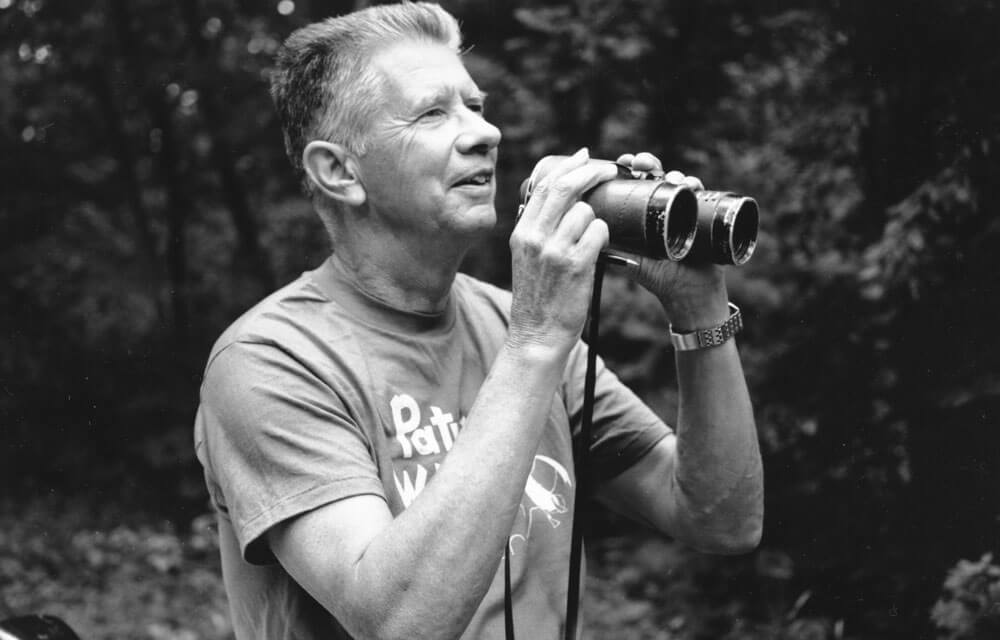
Chandler Robbins
Chandler Robbins joined the BBC at age 12 in 1930 and was a member until his death in 2017.
On Oct 23, 1991 the Conservation Committee was revived to further the club’s conservation efforts through coordinated initiatives in education, legislation, censusing, and volunteerism. Spring 1992 projects initiated by the committee were an Ipswich River Wildlife Sanctuary breeding bird census and a bird walk for children at Great Meadows. Trip leader Sabrina Hepburn remembers one Great Meadows walk where most of a troop of Boy Scouts showed up, working on their birdwatching badge. “It must have been one of the first warm days of the spring, and everywhere you looked there were Northern water snakes sunning themselves up and down the edge of the causeway. It was almost impossible to bring the attention of the boys back to birds once they started spotting and chasing snakes, but it was a great nature experience, so I still chalked it up as a win.” (Hepburn, 2013)
In 1991 the club suffered two significant losses. Ruth P. Emery, who was active in Bird Observer and served as the original Voice of Audubon, passed away at 93. Ruth and Margaret Argue had been elected the first women members of the Nuttall Ornithological Club in 1974.
Mary McCarthy, long time resident and teacher in Watertown who led many BBC trips in Mount Auburn, passed away and left a gift to the club that enabled the purchase of a computer to manage the membership database.
By 1994, club membership was booming. Of over 1300 members, 170 were from states other than MA. Heading the list was NH with 44, next was 27 in CT and 22 in NY, 17 in RI. Nine members lived in Maine, five in Vermont and Virginia, and four in Ohio, California and Michigan. There were also 1, 2, or 3 members in 16 other states. That year, the club set up an electronic mail branch of the rare bird alert hotline to supplement the phone hotline. In May 1996, the email hotline had 130 addresses and Barbara Volkle asked for volunteers to transcribe the rare bird alerts onto the club web page. Barbara also started MASSBIRD, a mailing list dedicated to the interchange of wild bird and birding information relevant to Massachusetts and New England. MASSBIRD was not a BBC club project, but soon became a popular tool for sharing trip reports and publicizing impromptu trips.
As the club grew, it expanded its contributions to conservation and education. In 1994, annual dues rose to $10, enabling the club to donate $200 to the Crane Reservation for Piping Plover and Least Tern protection, and $300 to Great Meadows N.W.R. toward the purchase of a harvester to control the growth of algae and water chestnuts, an aquatic weed. The BBC co- sponsored the 6th annual Birder’s Meeting Nov 19, 1994 with Massachusetts Audubon. Perhaps the most significant investment for the club that year was the purchase of a cassette player, projector, 40X40 screen and “Familiar Eastern Birds,” a set of slides from VIREO (Visual Resources for Ornithology), a photograph collection of The Academy of Natural Sciences. The Conservation Committee used the equipment to create presentations about bird behavior and identification for elementary schools and conservation groups. Starting in 1995, the club also developed identification workshops for members on spring warblers, fall sparrows, and waterfowl. The workshops, which consist of a classroom lecture followed by a field trip to practice ID skills, remain a popular offering in current Blue Books.
The Conservation Committee started a School Library Book fund in 1996. With the club matching a percentage of member contributions, John Melithoniotes delivered $470.00 of bird books (about 50 books) to the Roger Clapp elementary school in Boston in 1997, and another 35 bird books, CDs, and videos to the Perry school in 1998.
In March 1996, the Board approved a club web page on an experimental basis, stipulating that the trip listing include email addresses for most listing and avoid posting leader names or phone numbers unless authorized. After directors voiced concerns that membership would plummet when the trip listings became available online for free, the club decided to list Limited Participation trips in the printed Blue Book only.
“Raptor Heaven in 1997” was the apt title of statistician Bob Stymeist’s annual report that year. A highlight was a Boreal Owl that took up residence in the Back Bay from Nov 22 1996 through February 13, 1997. “Any errand to downtown became a pleasure with this reliable reward thrown in,” one member wrote. Notable sightings also included Black Vultures on the Dartmouth/Westport town line at a turkey vulture roost, Mississippi Kites in Rowley and Orleans, and a light-phase Swainson’s Hawk in West Newbury. The year’s most significant weather event was a devastating April storm broke many trees in Mount Auburn Cemetery; the club donated $500 toward tree cleanup. In a reference to the flagging economy, two members reported that their best birding experience of the year was “getting laid off in May.” On a more somber note, the statistician’s report noted the deaths of Skip Charette, Nancy Clayton, Jean Foley, Dick Forster, Josh Nove, Phil Parsons, and Nancy Powell: “They left the world diminished by their passing.” (Stymeist, 1997)
Glenn d’Entremont, who became club president in 1997, stressed energy awareness in Blue Book letters to members. “We, as Americans, consume 80 percent of the earth’s resources. We should be constantly monitoring our own consumption,” he wrote. d’Entremont urged members to design walks for public transportation users. The next president was Ida Giriunas, followed by Robert Petersen, and Linda Ferraresso. (d’Entremont, 1997.)
1998 featured the first weekend trip to Rangeley Lakes “to concentrate on Maine’s boreal specialties, including moderate hiking and canoeing.” Two Massachusetts trips were extended into the Granite State that year, to see a Varied Thrush just over the border and the Little Egret in Newmarket. On March 1, BBC trip participants viewed a Bullock’s Oriole in Reading at the feeder of Donna Schromm, who joined the BBC and served as Membership secretary from 2001- 2004.
The club continued to leverage new technology. Whale watching trips were scheduled on the fly on the first weekend day before or after a Noreaster and announced through the BBC phone and email hotlines and on MASSBIRD. The first BBC trip leaders to use Family Radio Service (FRS) radios were Fay and Peter Vale, who shared sightings when splitting large groups in Mount Auburn and Ipswich River Sanctuary. On the second Rangeley trip, in 1999, Mark Burns and Steve Leonard each brought a new FRS radio, without knowing that the other had one. “We used them on the hike up Mount Blue, the day we got the Three-toed Woodpecker,” trip leader Eddie Giles recalls. Steve chose channel 10/33 (the address of a former apartment), which became the club channel until the Board voted to adopt the national FRS channel of 11/22. Notes Giles, “I was on the Board at the time and recall fighting to keep 10/33 in memory of Steve,” who had passed away by then. “We still use 10/33 on my Rangeley trips,” he adds. (Giles, 2013.)
Other members and former members associate the club with successful “chases.” After moving to California, Alison Kent painted a portrait of the birding community, writing “In Praise of Massachusetts Birders” for the Blue Book. “As I write, seventy miles to my west is a bird that is a probable first for the Western hemisphere, a Greater Sandplover. […] In Massachussetts, a bird of this rarity would immediately have prompted two well-organized chases on consecutive weekend days, the call would have gone out on MASSBIRD and by phone telling people where to meet, what to expect, and what books to study, and there would have been at least 200 people from the Brookline Bird Club alone,” Kent speculated. “Following the ‘see the bird first, ask questions later’ rule, everyone, including beginners, would have been urged to come along.” She concluded, “Tomorrow’s leaders are today’s beginners. How we talk to them and respond to their reports determines whether they will join this community or not.” (Kent, 19XX)
The BBC did encourage beginners, particularly young ones. John Mittermeier describes being introduced to the Brookline Bird Club in 1999 as a seventh grader by Peter Alden. “Before long I was tagging along on BBC trips across the state: I saw my first Bald Eagle off the chain bridge near Newburyport with Peter, took a winter BBC trip to Gloucester with Linda Ferraresso, visited the Fenway Victory Gardens with Bob Stymeist when he found a MacGillivray’s Warbler and a Yellow-breasted Chat (Bob seemed surprised at the time that I was far more excited about the chat) and traveled to various corners of the state with Wayne Petersen, Simon Perkins, Marj Rines and others.”
Like many a new birder, John “worked through every page of the BBC’s blue outing booklet that year, folding corners and circling and highlighting trips that looked interesting.” He called or emailed the trip organizer, and “invariably they would be able to pick me up and give me a ride or know someone else going who could.” By the time spring rolled around, he was a fully committed Massachusetts birder biking over to Mount Auburn Cemetery every morning to join BBC trips before school.
In this case, the club actually helped to cultivate a professional ornithologist. “Thirteen years later, I am now a graduate student in ornithology working with Robb Brumfield at the Louisiana State University Museum of Natural Science in Baton Rouge,” writes Mittermeier. “My interests in birds and birding are still strong: I spent this past summer in Indonesia conducting bird surveys on Pulau Obi, a remote island in the Northern Moluccas of eastern Indonesia. Our work on Obi resulted in 14 new records for the island, including a four-inch long pygmy parrot that may be an undescribed species and resulted in some of the first photographs of the enigmatic Moluccan Woodcock. Over the next few years, I am hoping to continue my PhD research on island biogeography, speciation and conservation of birds in eastern Indonesia and develop this into a career in ornithology after graduation.”
He concludes, “Had it not been for the my early membership in the BBC and the exceptional generosity of Massachusetts birders in introducing me to birding, giving me rides to Plum Island, Gloucester, Quabbin Reservoir and others, and always encouraging my growing interest, I would not be where I am today.” (Mittermeier, 2013.)
A new generation finds the same support from current club members and leaders. Young birder Benjamin Peters notes that, “Every meeting and every trip I learn something new. Even though I’ve been a BBC member for only a year, I really enjoy the club and everything it does for birding in our area.” Asked about leaders who inspire him, he cites a May 5, 2012 trip where Dave Hursch “managed to get the Kentucky Warbler in the scope for everyone to see.”
Jeremiah Sullivan enthuses about his own experience. “I’ve been birding with the Brookline Bird Club for just over three years; in that time I’ve acquired many fond birding memories. Even on the first day at Dunback Meadow in Lexington, I knew this was something I wanted to do.” He cites the support of his father and leaders like Eddie Giles, “dogged in his pursuit of the Spruce Grouse and making sure I saw it,” Paul Ippolito, “when he realized a Ruffed Grouse would be a lifer for me, driving backwards on a narrow, dirt road so I could get out and see it,” and Marj Rines, who “helped build my early skills up so much by directing me to challenging programs, directing me to good birding locales and never allowing my young age to be a hindrance or keep me from participating in programs geared to adults.”
As the year 2000 approached, the media fanned fears that data storage where the year was represented with two digits could cause date-related processing to malfunction. The statistician’s report noted that birders were undaunted by the hype over “Y2K.” “Most of us ignored the warnings of the year, shut off our computers and went to bed early to start a New Year of birding,” wrote Bob Stymeist. (Stymeist, 2001.)
What a year it was! An all-time high of 290 club trips were scheduled in 2000: 73 all- day, 180 morning, 31 afternoon or evening, and six weekend trips. Eighty leaders guided club members. Among them was Helen Wilber Bailey, who led her 3rd annual weekend trip to Nantucket for Oldsquaw flights, inspired by a February 1987 Bird Observer article describing the flights at dawn and dusk of 100,000+ birds. The year 2000 also saw a dramatic increase in the number of pelagic trips, scheduled primarily through the efforts of Emmalee Tarry. A total of 13 pelagic trips were listed, including three dedicated charters, one to the far offshore area of Cashes Ledge. Other trips were whale watches from Newburyport, Gloucester, Plymouth, Barnstable, and Provincetown. On October 16, the club celebrated and acknowledged all its leaders at a Leader Appreciation Day at Wompatuck State Park in Hingham, that featured a barbecue and delicious desserts.
The biggest trip list of 2001 was Bill Drummond’s May 19 Newburyport trip, which reported 122 species. Bill commented that it was a poor migration day and that the group had to work hard for every species, but nonetheless they recorded a late Snow Goose, a Ruff and a Reeve at the salt panes on Plum Island, a “grand slam” on all of the swallows, and 17 species of warblers. (Stymeist, 2001.) On November 25, Jonathan Center extended his own Newburyport trip to Cape Neddick, Maine to add the Sage Thrasher to the club list, only to find another BBC trip already there. Through the hotlines, Bill Drummond had added an unscheduled trip to ensure getting the bird for the club list. There is only one other record of the species in New England, photographed at Plum Island Oct 26, 1965. It seems appropriate that the Brookline Bird Club donated $11,000 to Massachusetts Audubon that year for its new Joppa Flats center, the total composed of individual member donations plus a club donation.
At the Annual Meeting April 26, 2002 Shawn Carey first presented his 16-minute DVD movie “Looking Skyward: A Passion for Hawk Watching.” Shawn then played the video “Kestrel’s Eye” from Sweden. Coincidentally, a Eurasian Kestrel was seen the week before at Chatham, but not reported for five days. For those who had not seen the kestrel, “the 90 minutes were a nightmare. But for just about everyone else, it was one of the most popular videos ever shown at a BBC meeting and the auditorium was packed,” wrote William Drummond, corresponding secretary and former club president. Fortunately, he saw the bird the following Monday. (Drummond, 2002.)
The club celebrated its 90th Anniversary on November 8, 2003 at the Peabody Marriott Hotel. The occasion featured a cocktail reception, vendors, and a catered dinner. Highlights included a slide show of member photographs, door prizes, and a keynote address by birding guide Shawneen Finnegan, followed by coffee and dessert. The evening was topped off by the audience participation game, “Who Wants to Be a Birder?” hosted by Eddie Giles.
Member Doug Chickering recalls that, “Although a bit anomalous in its formality, it was an evening of the club. Every Massachusetts birder knows exactly what you mean when you refer to the Club, just as they know what is meant by Gate 45, or Hellcat, or Marconi, or the Dell. All are integral parts of our lives, points of reference in our endless adventure. Some of the faces on the screen are gone, the others have grown old; but the birds are forever.” (Chickering, 2003.)
Former president Steve Grinley adds, “Yet on this evening of the lunar eclipse, the talk was not all about birds. During dinner, there were beautiful pictures of birds flashed up on the two large screens at either end of the room. A Plum Island Snowy Owl., the Boston Gyrfalcon, the Essex Rufous Hummingbird, the Salisbury Ivory Gull, the Rowley Great Grey Owl and, of course, the Ross’ Gull that put Newburyport on the birding map in the mid-70s. But interspersed there were many more photos of members. Many of us saw our younger and thinner selves, in birding garb that would embarrass us today. For me the evening was not about seeing, again the Ross’ Gull, but seeing, again lost friends Herman Weisberg and Phil Parsons, who originally found the bird.” (Grinley, 2003.)
The club’s 91st year was a banner year for sightings. The club list total of 311 was an astonishing 86% of all the species seen statewide in 2004. These species included a Red-footed Falcon, the first confirmed record for Massachusetts and North America. Club members saw the falcon on both a diverted and an extended South Beach trip Aug 14, the first weekend day after its discovery. An “army of birders stormed the island” by noontime, including the colorful members of a special club trip led by Eddie Giles, the Hawaiian Shirt Shorebird Safari to South Beach. (Stymeist, 2005.) The original trip was not cancelled; Mark Burns led 11 other members over to the beach and on to the Vineyard afterwards to see the falcon that evening.
Members continued to seize opportunities to observe birds at sea. On August 28, 2004, an “extreme pelagic” scheduled to Hydrographer Canyon was a remarkable adventure for 80 birders who departed Hyannis Harbor at 4 a.m. The trip never reached its original destination, diverting to Veatch’s Canyon from Hydrographer when satellite images revealed water temperatures of nearly 80 degrees. The trip recorded Audubon’s Shearwater, Band-rumped Storm-Petrel, Great and South Polar Skuas and Bridled Tern, some birds flying alongside the boat and others perched on floating wood. In addition to these great birds, participants enjoyed Basking Sharks, two Hammerhead and one Blue Shark, and hundreds of flying fish.
In 2005, under club president Joseph Paluzzi, the club held its first Winter Lecture meeting, in Bedford. Featured speaker Wayne Petersen delivered a talk on shorebirds. For ten years, the club had absorbed increased Blue Book production and mailing costs, bought a new computer, and donated funds to conservation groups without increasing dues. To maintain financial stability and continue giving members the best programs available, annual dues were raised to $15. At the spring meeting, Dr. John Kricher of Wheaton presented some new information on global warming and its possible effect on migratory patterns. Donald Kroodsma, author of The Singing Life of Birds, presented a fascinating Fall meeting lecture featuring slides and recordings of birdsong. The club continued to support local conservation projects, contributing $1,000 to Barnstable Land Trust to help buy two acres amid over 105 protected acres in the Cummaquid section, inhabited by woodcock, bluebirds, bobwhite, and raptors.
Dennis Oliver retired from the Board of Directors in 2006, after 22 years on the Board, including serving as Recording Secretary from 1987 to 2004. Dennis also coordinated and compiled the Ipswich River Breeding Bird Survey for over 15 years. He also took part in many TASL counts, the Cape Cod Waterfowl Survey, and three Christmas Bird Counts, serving as Waltham section leader for the Greater Boston Count. His brother David reports that they first encountered a BBC trip led by Jerry Soucy and Judge Jodrey in November 1977 on Plum Island. Nancy Clayton, along on the trip, was “delightful, warm, and embracing. She gave us our first blue book and from there we went on as many BBC trips as we could. We wished we could attend every one.” (Oliver, 2006.)
Laura de la Flor became club president in 2007. Pelagic trip organizer Ida Giriunas added another unscheduled Hydrographer Canyon trip August 19, where almost 70 participants enjoyed a record number of Audubon’s shearwaters 17 and “killer looks” at five sperm whales. (Stymeist, 2008.) Three Bridled Terns and six species of whales and dolphins highlighted the first trip to the offshore canyons on July 19. A Little Shearwater recorded August 25 was the first documented sight record for North America and a new species for Massachusetts bird list.
The sixth annual Winter Meeting featured the first Members Night, held at the John Glenn Middle School in Bedford on Friday February 29th, 2008. Slide and video talks by members ranged from unusual bird lists to trip reports in New England and Africa. 2008 also offered the first Cape Cod Waterfowl Prowl, led by Eddie Giles and Mary Kelleher on March 15, 2008. Attempting to locate as many of the 29 species of ducks as possible in one day on Cape Cod ponds, the group saw 27 duck species and 61 species overall.
In “Back to Basics,” a Blue Book message from club president Barbara Volkle urged “Take someone birding! … It is critical that each of us take these steps to reconnect people around us, especially young people, to the natural world. Birding can be that connection and the Brookline Bird Club can support that connection.” (Volkle, 2008.) The club connected current and potential members via social media for the first time that year. Its Twitter account (bbcbirds) spreads small snippets of information quickly, such as rare bird sightings, trip cancellations, or updates. The club’s Facebook page (Brookline Bird Club) shares photos, links and videos with members.
Word spread about rarities enjoyed on BBC pelagic trips. The July 18, 2009 pelagic, the club’s first trip to Atlantis Canyon, was booked solid with several on the wait list. As in previous years, participants came from every New England state and from other areas including Oklahoma, Missouri, New York, Georgia, and Montreal. The trip did not disappoint, producing the club’s first Black-capped Petrel, a new state high record of 19 Audubon’s Shearwaters, and 58 Leach’s Storm-Petrels. On September 3, a twice-postponed trip to the Continental Shelf smashed state records for White-faced Storm Petrel, Band-rumped Storm-Petrel, Bridled Tern, and Long- tailed Jaeger.
In April 2010, the Blue Book introduced Birding 101, “trips ideal for beginners or nonbirding friends (‘pre-birders’) who might like to come along and see what it’s all about.” There was no better example of what it was “all about” than Doug Chickering’s nomination for best bird of 2010. “Without a doubt the best bird of the year is one that nobody saw,” Chickering wrote of a twilight gathering to listen, moments before the refuge closed for the night. “I don’t think I have ever seen so many birders so delighted NOT seeing a bird – that great phantom of birding, the Black Rail. I still get a quiet pleasure when I recall that ki-ki-krrr drifting over to us in the gathering darkness from the North Pool on Plum Island.” (Stymeist, 2011.)
In 2011, as always, the club co-sponsored trips with organizations with similar interests. Familiar partners included the South Shore Bird Club, Athol Bird and Nature Club, Menotomy Bird Club, Essex County Ornithological Club, and Take a Second Look. Leaders also connected the club with their own local environmental organizations, such as the Woburn Residents Environmental Network, Nahant Open Space Committee, Assabet River NWR, the Merrimac and Ipswich River Watershed Councils, Trustees of Reservations, Halibut Point State Park, Boston Nature Center, Forest Hills Educational Trust, Arboretum Park Conservancy, the Frederick Law Olmstead National Historic Site, and the Waquot Bay National Estuarine Research Reserve. While such cross-pollination attracted some new members, membership numbers continued to fluctuate. Brookline Bird Club membership totaled 1274 in 2002, declined to 1183 in 2005, jumped to 1263 in 2006, and dropped to 1020 in 2010. In 2011, the total began to climb again with an annual total of 1146.
President Edward M. Giles took office in 2012 to lead the club into its centenary year. The speaker for the February 3 winter meeting was Greg Miller, whose 1998 quest to see as many birds as possible in a single year was the subject of a movie. BBC birders gathered to view the film in Burlington, Massachusetts together earlier that year, complete with a parking lot tailgate party to share refreshments. For 2013, the BBC plans its own Big Year, an effort to break the club records of 302 species seen on BBC trips in Massachusetts and 314 on BBC trips throughout New England. A special series of trips emphasizes some of the most elusive species, and visitors to the club web page can track the club’s progress through the year there.
Officers and trip leaders reflect on the club’s future and its role in the lives of local birders. “When I was working, birding was a lifesaver, and it helped me keep my sanity; now, in retirement, birding is a lifesaver because it helps me to keep getting around,” explains former president Ida Giriunas, honored with a Certificate of Appreciation by the club October 12, 2007.
Jim Berry put it this way: “This club has brought along hundreds if not thousands of new birders over the decades, and we have branched out in many directions, making contributions to field ornithology and bird conservation each in our own way. but many of us still lead walks for the BBC, and I think it’s out of gratitude as much as anything else. At least that’s why I still do it.”
Paul Roberts notes, “Now the challenge is how can everything the BBC offers benefit people who rely increasingly on the internet and ‘digital birding,’ and consequently are often birding alone. People need what the BBC offers now more than ever.”
Barbara Volkle calls this a time of transition. “Things changed when we moved to email and the web. While information is more immediate, we’ve lost the need to speak with each other about what was seen when. This makes it all the more important for clubs – we mentor, we talk about ethics, we share comradery and experiences – so it’s about birding with each other and as a community.”
Birders continue to flock to the club. Guests hear about it from friends, through chance meetings in the field, or via MASSBIRD trip reports. Membership secretary Leslie Kramer reports that renewals for 2013 already exceed the trend of recent years, with 793 renewals and 11 new members as of January.
In 1975, the club received a letter from Helen Kaan, whose mother, Mary Moore Kaan, organized the first meeting. Helen donated $500 to the BBC to keep dues low in memory of her mother and remarked that it was “wonderful that the club has kept its original character and purpose through all these changing years.” The Brookline Bird Club, she felt, had fulfilled Mary Kaan’s dream. The club still unites birders of all ages and abilities to study and protect New England’s avian life. Its strength is the variety of opportunities for participants: lectures, workshops, volunteer projects and, of course, a list of trips as diverse as New England’s habitats. Trips have birded Nauset Marsh by kayak and Rangeley Lakes by canoe and taken the aerial tramway to the top of Cannon Mountain for Bicknell’s Thrush. Members have trudged the sandy length of Plymouth Beach and the changing perimeter of Monomoy Island, scanned the wilds of Quabbin and the walls of the Worcester Art Museum, sailed to deep water canyons, and waited at backyard feeders. They have photographed, sketched, tweeted, atlased and surveyed. As long as there are local nesters, migrants, or storm-blown vagrants, BBC birders will seek them out to study and share. The future of the Brookline Bird Club looks bright, as its vibrant membership and creative leaders embark on the adventure of the club’s next century.
